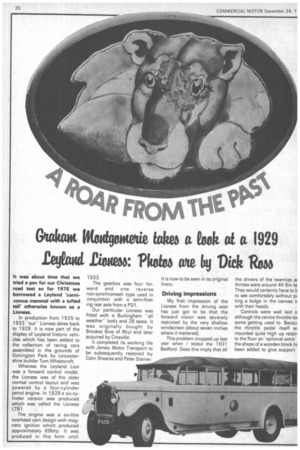Wog *gig°male falzeh a took at a 1929
Page 22

Page 25

If you've noticed an error in this article please click here to report it so we can fix it.
fegtaid .Ciegem: Plain au by Dirk ROM
It was about time that we tried a psv for our Christmas road test so for 1 976 we borrowed a Leyland 'carnivorous mammal with a tufted tail' otherwise known as a Lioness.
In production from 1925 to 1933 "our" Lioness dates back to 1929. It is now part of the display of Leyland historic vehicles which has been added to the collection of racing cars assembled in the grounds of Donington Park by Leicestershire builder Tom Wheatcroft.
Whereas the Leyland Lion was a forward control model, the Lioness was of the older normal control layout and was powered by a four-cylinder petrol engine. In 1929 a six-cylinder version was produced which was called the Lioness LTB1.
The engine was a six-litre overhead cam design with magneto ignition which produced .approximately 69bhp. It was produced in this form until
1933.
The gearbox was four forward and one reverse non-synchromesh type used in conjunction with a semi-floating rear axle from a PD1.
Our particular Lioness was fitted with a Burlingham "all weather" body and 26 seats. It was originally bought by Brookes Bros of Rhyl and later acquired by Crosville.
It completed its working life with Jersey Motor Transport to be subsequently restored by Colin Sheares and Peter Stanier. It is now to be seen in its original livery.
Driving impressions
My first impression of the Lioness from the driving seat has just got to be that the forward vision was severely restricted by the very shallow windscreen (about seven inches where it mattered).
This problem cropped up last year when I tested the 1931 Bedford. Does this imply that all the drivers of the twenties al thirties were around 4ft 6in ta They would certainly have to b to see comfortably without pt ting a bulge in the canvas tt with their heads.
Controls were well laid o although the centre throttle to some getting used to. Becau: the throttle pedal itself w. mounted quite high up relatil to the floor an 'optional extra' the shape of a wooden block hz been added to give support a lot of engine revs if the road speed was much above 20mph.
It was far safer to let the vehicle speed drop right down and then give a gentle blip which resulted in the proverbial knife-through-butter gear change. This means that slowing down the Leyland had to be done on the brakes with very little assistance from the engine.
I was very surprised at the amount of stopping power that the Lioness could summon up if necessary — brakes on commercial vehicles, be they for trucks or buses, before 1939 were never renowned for their performance but the servo-assisted hydaulic system on the admittedly unladen Leyland worked beautifully. Mind you, a fairly hefty prod at the right-hand pedal was still necessary but at least it produced the results.
The handbrake was a conventional trigger release type mounted on the driver's right. As with the hydraulic brakes, this mechanical brake was very effective. The only thing I had to remember was that the handbrake worked the opposite way round to normal ie push it forward to apply. .
I think the Lioness had a problem with a slight misalignment in the steering department as the steering was far heavier on left lock than on right.
On right lock, the steering was precise and the effort required on very sharp corners was obviously more than with today's coaches, but it was still acceptable.
On left lock however it really needed to be manhandled round the bends. Precision was also lacking as it would not hold to a turn of constant radius without meandering off on its own. I think this was merely a fault of adjustment on our particular Lioness which would not occur on other similar machines.
Instrumentation consisted of a speedometer, an ammeter and an oil-pressure gauge. The layout was odd though because the speedometer was over on the nearside of the instrument panel and completely invisible from the driver's seat. Perhaps it was an added attraction for the front seat passengers that they could watch the needle as it rushed round to an uncontrolled terminal velocity of around 55mph?
Engine accessibility was very good especially when compared with the modern day underfloor counterpart of the Lioness.
The bonnet came off completely in three separate sections rather than being hinged in the middle. The two side panels were removed and then the top portion was lifted forward over the radiator.
Seen from the offside, the six-cylinder petrol engine presented an uncluttered appearance but this was an artificial situation as all the ancilliaries such as carburetter, magneto, manifolds, etc, were all mounted on the nearside!
Ignoring the presence of the spark plugs, the cylinder block bore a curious (?) resemblance to the same component of the current 500 series diesel engine especially around the block / crankcase joint.
The Donington Collection (they don't like it being called a museum) now includes a crosssection of vehicles with speeds ranging from about two to 250mph..As well as the Leyland name, the marques of Thorneycroft, Albion, Guy and Austin are also represented. It is well worth a visit for motor racing and transport enthusiasts alike and is very easy to find being situated on the A453 just a few minutes off junction 24 on Ml




































































